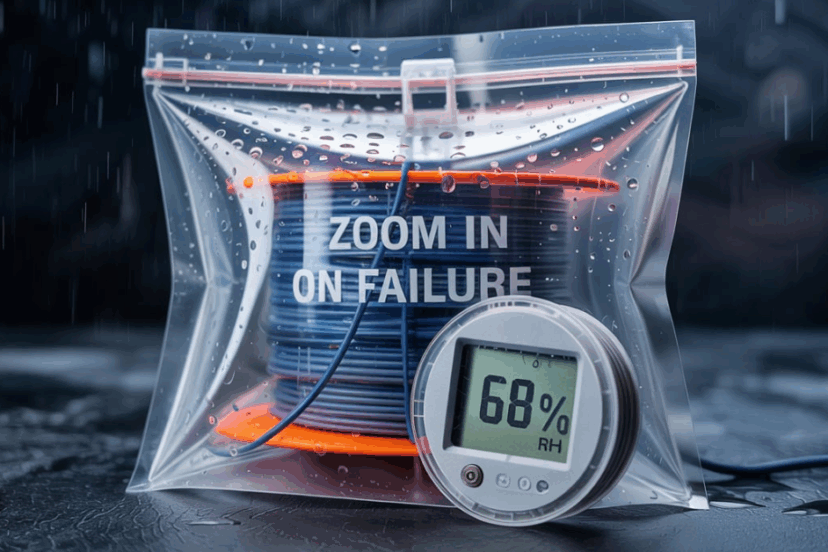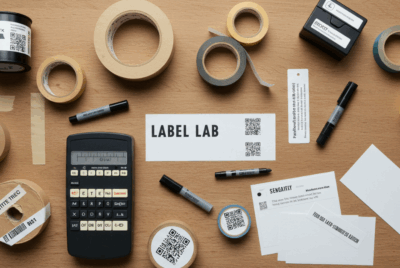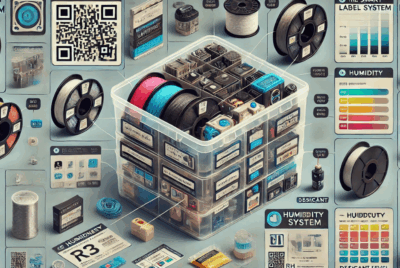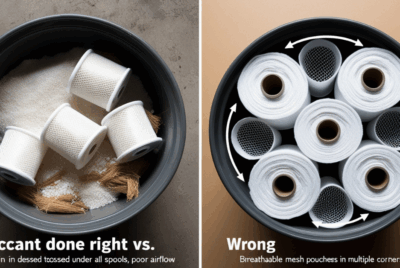Can storing filament in original packaging keep it safe long-term?
1. The Packaging Debate
You just got your shiny new spool of filament. It’s vacuum-sealed, bagged, boxed—and looks pretty secure.
The question is:
Can you just leave it like that and toss it on a shelf until you’re ready?
Let’s break down whether original packaging is good enough for long-term filament storage—and what you should do instead.
2. What’s Included in Most Original Filament Packaging?
Typically, brand-new filament comes with:
- A vacuum-sealed plastic bag
- A small silica gel pack
- A cardboard or plastic box
- Labels with temperature and material info
It looks secure, and to be fair—it often is. At least at first…
3. Is Factory Packaging Really Airtight?
Yes—when it’s brand new.
But over time, even vacuum-sealed bags can develop micro-leaks, especially at seams or weak spots in cheaper packaging.
And cardboard boxes? Definitely not airtight.
4. How Long Is Filament Safe in Its Original Package?
If it’s unopened and sealed:
- PLA and ABS: 12–24 months
- PETG, TPU: 6–12 months
- Nylon, PVA: 3–6 months
📌 But once opened—even just once—it starts absorbing moisture immediately.
5. Why Original Packaging Isn’t Enough for Long-Term Storage
Here’s the problem:
- Silica gel inside gets saturated over time
- Vacuum bags lose pressure slowly
- Most brands use single-layer plastic, not barrier-grade film
- Boxes let in light, heat, and air leaks
Bottom line? Original packaging is temporary protection, not a long-term solution.
6. Does It Matter If It’s Been Opened Before?
Absolutely.
If the seal is broken—even once—the filament is exposed to moisture. Resealing with tape or a zip bag won’t restore its original protection.
You need to dry the filament and then re-seal it properly.
7. What If the Spool Is Vacuum-Sealed with Desiccant?
This is your best-case scenario.
✅ Still vacuum-packed
✅ Silica gel included
✅ Stored in a cool, dry place
If all that’s true, you’re probably fine for 6–12 months—especially for less-sensitive filaments like PLA.
Still, add a hygrometer check every few months if stored long-term.
8. What About Cardboard Boxes or Non-Sealed Bags?
Nope.
Boxes and loose bags:
- Allow humidity to seep in
- Trap temperature fluctuations
- Offer no airtight barrier
If your filament came this way, repackage it ASAP using vacuum-sealed bags or airtight bins with desiccants.
9. What Happens If You Leave It in the Box on a Shelf?
If stored for too long like this:
- Moisture creeps in
- Print quality drops (stringing, popping, poor adhesion)
- Filament becomes brittle or gummy
This might be fine for a month or two in a dry climate, but in most places, you’re gambling with your print success.
10. Best Practices After You Open the Package
Once opened:
- Dry it if unsure of condition
- Store in a vacuum bag or airtight bin
- Add fresh silica gel packs
- Use a label for opened date and filament type
- Print within a few weeks—or reseal again
11. When to Switch to Dedicated Storage Solutions
Move beyond original packaging if:
- You’re printing sporadically
- You store filament for more than a month
- You use moisture-sensitive materials
- You live in a humid or coastal region
Airtight bins, vacuum sealers, or dry boxes are essential upgrades.
12. How to Reinforce the Original Packaging (If You Must)
If you’re stuck using the original bag:
- Tape the open edge tightly
- Add new silica gel packs
- Place inside a Ziploc freezer bag or airtight bin
- Store in a cool, dark place away from sunlight or heat
Just know: it’s a short-term fix.
13. Materials That Handle Long-Term Packaging Better
Some filaments are more forgiving:
| Filament | Long-Term Packaging Risk |
|---|---|
| PLA | Low (up to 12–18 months if unopened) |
| ABS | Moderate |
| PETG | High |
| Nylon | Very High |
| TPU | High |
| PVA | Extremely High (never store long-term in original bag) |
14. Manufacturer Differences: Not All Packaging Is Equal
Top-tier brands like Polymaker, MatterHackers, or Prusament often use:
- Thicker vacuum bags
- Better desiccant packs
- Quality seals
- Labeled RH limits and storage tips
Budget brands? Not so much. Always repackage unless you trust the quality.
15. Final Thoughts: Don’t Rely on That Shrink Wrap Forever
The packaging your filament arrives in isn’t built for the long haul.
It’s fine for shipping. It’s fine for a few weeks.
But for real filament longevity, you need to:
- Store it airtight
- Keep it dry
- Control humidity
Treat your filament like you would treat food: sealed, dry, and protected.
❓FAQs
- Is unopened filament safe for a year?
Yes, if it’s vacuum-sealed and stored in a cool, dry place. PLA can last up to 2 years this way. - Do I need to dry filament that’s still in its original seal?
If you’re unsure of how long it’s been stored, it’s smart to dry it—especially for sensitive materials. - Can I reuse the original vacuum bag after opening?
Technically yes, but it won’t seal as well. Use a vacuum sealer or upgrade to better bags. - Should I store the box and label with the filament?
Yes! Save the box or cut off the label to keep track of the material, color, and brand. - What’s better than original packaging for storage?
Vacuum-sealed bags with silica gel, airtight storage bins, and dry boxes with RH control.




